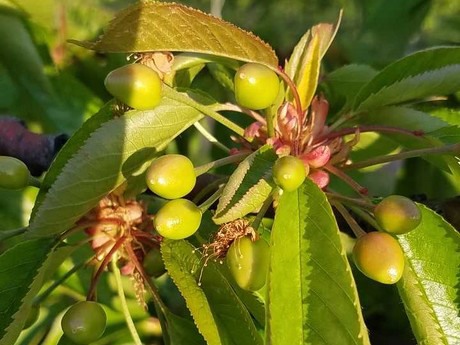Arrivals of Chilean cherries into the US are imminent, with some fruit already reported to have arrived. While shipments of cherries from Chile to China have already started, arrivals to the US are slow in coming. Additionally, the crop will be a little smaller than the record crop last year of 39 million boxes, and looks to have been lessened further due to some cooler weather and rain in recent weeks, according to Broc Bengard of Bengard Marketing.
"A few exporters have sent some shipments to the US but the majority of arrivals are not due until next week although wet weather expected this past weekend through early next week may delay things a bit further," Bengard noted. "Expectations were for the crop to come in around 34 - 36 million boxes this season. However, with a wet spring and recent colder weather during the bloom, it might have reduced the crop to 31 - 33 million, which equates to being around 15 - 20 percent off of last year."
Furthermore, the first arrivals of cherries appear to be of a less favored variety. "The majority of the early arrivals are of the Burlat variety, despite them showing up as 'Bing' on the system," Bengard explained. "This is a softer, early variety and due to its softer nature and lower sugar, retailers have little interest in it. From the following week however, we should start to see Royal Dawn, followed by some Santina variety starting to arrive."
Effects of the weather-affected crop
The cooler weather will have other effects on the season than just reduced volume. The weather has caused the harvest to be pushed back a little, but mainly for the early varieties at this stage. If this is the case, it means the harvest and arrivals could be compressed.

Taken in early October. Image: Bengard
"Fruit has been slow to arrive," Bengard said. "There is good demand for first orders as everybody is waiting for shipments to arrive and subsequently fill shelves. As the harvest has been pushed back, we are expecting the harvest to be more concentrated. This will allow for good promotional opportunities with concentrated volumes on arrival."
Bengard added that fruit quality should also be good this year. "With the reduced volume compared to last year, this should result in a more manageable crop for slower packing," he said. "Additionally, there is less stress on the trees with less fruit, which usually translates into a stronger fruit quality and condition for the final consumer."
MAP testing and growth in organic category
There are some noteworthy developments in this year's Chilean cherry season. Firstly, Bengard said that some shippers are testing the effects of a new method using modified atmosphere packaging. "There are some test shipments coming with modified atmosphere using clamshells," he shared. "The clamshells will have a single-layer modified atmosphere overwrap, which will be inspected upon arrival as well as through the supply chain to see how they hold up."
Another aspect to note this season is the increase of organic supply from Chile. Suppliers say demand for organic cherries is such that a premium category of air-freighted, organic cherries will have its presence increased on the market. "This will be the first year with much larger availability of organic cherries by air," Bengard observed. "It's targeted for the premium market, with the intention that the cherries arrive in the best possible condition."
"Also for the first time in many years, retailers and consumers can expect the entire availability on big sizing and strongest fruit, since organic production was intended for our market," he continued. "Just over a decade ago the USA market was the main destination for Chilean cherries. Compare this to today where China now takes just over 90 percent of the entire Chilean conventional cherry crop while last year the U.S. market received just under 4 percent. I’m glad to have an opportunity with organic to put the best and biggest back in stores for customers to enjoy from Thanksgiving through the end of December."
For more information:
Broc Bengard
Bengard Marketing, Inc.
Tel: +1 (310) 605-5105
broc@bengard.us
www.bengard.us
